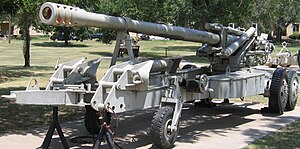GC-45 howitzer
| GC-45 155 mm Howitzer | |
|---|---|

|
|
| Type | Howitzer |
| Place of origin | Canada |
| Service history | |
| Used by | Thailand Iran China Kuwait Israel Iraq Singapore Saudi Arabia |
| Wars | Iran–Iraq War, Gulf War, Cambodian–Thai border stand-off |
| Production history | |
| Designer | Gerald Bull |
| Designed | 1970s |
| Manufacturer | Space Research Corporation, Noricum, NORINCO |
| Variants | GHN-45, PLL01 |
| Specifications | |
| Caliber | 155 mm (6.1 in.) |
| Carriage | split trail |
| Elevation | -89 to 1,280 mils |
| Traverse | Left 534 mils, Right 711 mils |
| Rate of fire | maximum: 5 rpm sustained: 2 rpm |
| Muzzle velocity | 897 m/s (2,943 ft/sec) |
| Maximum firing range | 39.6 km (24.6 mi) with Base bleed |
The GC-45 (Gun, Canada, 45-calibre) is a 155 mm howitzer designed by Gerald Bull's Space Research Corporation (SRC) in the 1970s. Versions were produced by a number of companies during the 1980s, notably in Austria and South Africa.
The most publicized use of the design was in Iraq, where the GHN-45 variant used by some Iraqi artillery units had a longer range than any coalition cannon systems. This initially caused considerable worry on the part of the allied forces in the Persian Gulf War.
The GC-45's general design followed several decades of work by Bull with fin-stabilized artillery shells, starting at the Canadian Armament Research and Development Establishment (CARDE) and later at Project HARP. In these efforts accuracy was not a huge concern, the objective was muzzle velocity, and the test articles were finned darts representing missiles, a low-cost alternative to wind tunnels. Yet with the removal of the rifling and the soft-metal driving band on the shell itself, the shell could be designed purely for ballistics, as opposed to having the external constraint of the driving band. A system combining some sort of rifling for accuracy without a driving band would result in a longer-range weapon. However, such a design was never achieved.
After years of research at his Quebec firing range, Bull eventually settled on a solution. The resulting Extended Range, Full Bore (ERFB) ammunition was key to SRC's designs: a "pointy" looking shell with much lower drag at supersonic speeds. For longer range applications he added a base bleed system (invented in Sweden) that could be screwed onto the standard shell, as well as an even longer-ranged system with a rocket booster.
...
Wikipedia
